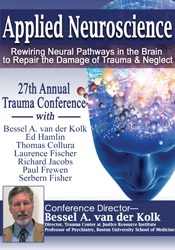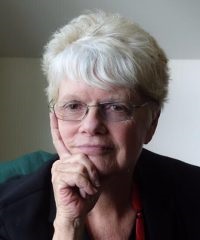
Applied Neuroscience: Rewiring Neural Pathways in the Brain to Repair the Damage of Trauma & Neglect
Credit Available - See CEUs tab below.
- Categories:
- Trauma and PTSD
- Faculty:
- Bessel A. van der Kolk, MD | Ed Hamlin, PhD | Thomas Collura, PhD | David Hagedorn, PhD | Laurence M Hirshberg, PhD | Paul Frewen, PhD, CPsych | Rex L. Cannon, PhD | Sebern Fisher, MA, BCN | Richard Jacobs, PsyD
- Duration:
- 6 Hours 30 Minutes
- Format:
- Audio and Video
- Original Program Date:
- Jun 02, 2016
- SKU:
- POS051180
- Media Type:
- Online Learning
Description
Learn breakthrough applications of EEG neurofeedback from today's leading experts.
This applied neuroscience track brings together researchers, engineers, clinicians and neurobiologists who are exploring ways in which computers can assist in the modulation of focusing, arousal, and filtering, and thereby shape mental and physiological self-experience. One of the oldest, and best researched, approaches for improving self-regulation of the central nervous system is neurofeedback, which has been applied in a variety of settings.
In this workshop participants will be exposed to an overview of arousal dysregulation in severe emotional disorders and ways in which technology can be used to regulate arousal and improve emotional and behavioral functioning. We will explore the use of the quantitative EEG, and review the development of instrumentation that can help with “essential self-experiences”.
OUTLINE
Introduction of Bessel van der Kolk
- How trauma disturbs brain development
- Childhood Trauma
- Attachment issues
- Brain Development
- Social Experiences
- Attachment issues
- Electro-connections of the brain
- Traumatized vs. “Normal” people
- How to help traumatized people not be focused on the past
- Questions
Introduction of Laurence Hirshberg
- Neurofeedback
- What it is
- How is works
- Supporting research
- What we know vs. what we don’t know
- Why you would want to change the EEG
- Finished existing research on what the EEG abnormalities are with PTSD
- What the evidence that you can actually change the EEG
- Early studies of the efficacy of neurofeedback in early childhood trauma
- Questions
Introduction of Tom Collura
- Clinic work
- Process of neuroscience within the clinic
- Process of working with the patient when using neurofeedback
- “Normal” people distributions vs. traumatized people distributions
- Z-score training
- Clinic research findings with patients
- State and trait characteristics
- Left vs. Right brain
- Questions
Introduction of Richard Jacobs
- Aspects of neurofeedback and how they can help people
- Personal neurofeedback story of Richard Jacobs
Introduction of Paul Frewen
- MEG studies on PTSD subjects
- PTSD patients vs patients under psychedelic drugs
- Positive and negative experiences of psychedelic drugs
- Neurofeedback studies
- Questions
Introduction of Sebern Fisher
- The role of neurofeedback in the treatment of developmental trauma
- Default mode network
- Case studies of neurofeedback
- EEG and clinical changes
Introduction of Ed Hamlin
- History of the mind vs. the brain
- Complexity of the brain
- Consciousness in the brain
- Brain networks
- What parts of the brain process what
OBJECTIVES
- Summarize the recent developments in neuroscience as they relate to the treatment of trauma.
- Explore ways in which computers can assist in the modulation of focusing, arousal, and filtering.
- Describe the role of specific neuronetworks associated with trauma.
- Demonstrate how to provide non-invasive office-based electrophysiology measures of both central and autonomic nervous system functions.
- Summarize an overview of arousal dysregulation in severe emotional disorders.
- Utilize technology to regulate arousal and improve emotional and behavioral functioning.
- Identify the default mode network that is associated with dysfunctions associated with PTSD.
- Explore the use of the quantitative EEG.
Satisfaction Guarantee
Your satisfaction is our goal and our guarantee. Concerns should be addressed to PESI, Inc., PO Box 1000, Eau Claire, WI 54702-1000 or call 1-800-844-8260.
ADA Needs
PESI would be happy to accommodate your ADA needs; please call our Customer Service Department for more information at 800-844-8260.
CEUs
This course is available for 7.0 total CPDs.
The HPCSA has declared that any on-line courses CPD/CEU credited by a certified US board, is automatically CPD/CEU credited in South Africa.
As there are different boards for different disciplines, we at Acacia suggest that you use the Counselling CPD/CEU credits. These correspond to South African credits of one CPD/CEU per 60 minutes. If you choose to use your discipline's credits, please do so at your discretion.
PESI, Inc. is an approved provider with the Florida Board of Clinical Social Work, Marriage and Family Therapy and Mental Health Counseling. Provider Number 50-399. This self-study course qualifies for 7.0 continuing education credits.
Handouts
| File type | File name | Number of pages | |
|---|---|---|---|
| Link | Download for Thomas Collura Handouts/Papers |
Faculty

Bessel A. van der Kolk, MD Related seminars and products
Trauma Research Foundation
Bessel A. van der Kolk, MD, is a clinician, researcher and teacher in the area of post-traumatic stress. His work integrates developmental, neurobiological, psychodynamic and interpersonal aspects of the impact of trauma and its treatment.
Dr. van der Kolk and his various collaborators have published extensively on the impact of trauma on development, such as dissociative problems, borderline personality and self-mutilation, cognitive development, memory, and the psychobiology of trauma. He has published over 150 peer-reviewed scientific articles on such diverse topics as neuroimaging, self-injury, memory, neurofeedback, Developmental Trauma, yoga, theater, and EMDR.
He is founder of the Trauma Center in Brookline, Massachusetts and President of the Trauma Research Foundation, which promotes clinical, scientific, and educational projects.
His 2014 #1 New York Times best seller, The Body Keeps the Score: Brain, Mind, and Body in the Treatment of Trauma, transforms our understanding of traumatic stress, revealing how it literally rearranges the brain’s wiring – specifically areas dedicated to pleasure, engagement, control, and trust. He shows how these areas can be reactivated through innovative treatments including neurofeedback, somatically based therapies, EMDR, psychodrama, play, yoga, and other therapies.
Dr. van der Kolk is the past president of the International Society for Traumatic Stress Studies, and professor of psychiatry at Boston University Medical School. He regularly teaches at conferences, universities, and hospitals around the world.
Speaker Disclosures:
Financial: Dr. Bessel van der Kolk is a professor at Boston University School of Medicine, the Director of the Trauma Center, and the National Complex Trauma Network. He receives royalties as a published author. Dr. van der Kolk receives a speaking honorarium, recording royalties, and book royalties from PESI, Inc. He has no relevant financial relationships with ineligible organizations.
Non-financial: Dr. Bessel van der Kolk has no relevant non-financial relationships with ineligible organizations.
Ed Hamlin, PhD Related seminars and products
Ed Hamlin, Ph.D.: Clinical Director, Pisgah Institute’s Center for the Advancement of Human Potential, Ashville, NC; adjunct faculty, East Tennessee State University Medical Center and Western Carolina University.
Thomas Collura, PhD Related seminars and products
Thomas Collura, PhD, Founder and president of BrainMaster Technologies, Inc. Formerly at AT&T Bell Laboratories working on integrated circuit technology, computer graphics, networking, and man/machine interfaces. He holds 3 patents and has 3 patents pending, in the areas of neurofeedback evoked potential methods. Past President of the International Society for Neurofeedback and Research (ISNR).
David Hagedorn, PhD Related seminars and products
David Hagedorn, PhD, President, Chief Executive Officer, and Chief Science Officer, Evoke Neuroscience, Inc, Assistant Professor of Military and Emergency Medicine and Family Medicine at Uniformed Services University of the Health Sciences - School of Medicine.
Laurence M Hirshberg, PhD Related seminars and products
Laurence M. Hirshberg, PhD, Department of Psychiatry and Human Behavior, Alpert Medical School, Brown University; The NeuroDevelopment Center, Rhode Island, specializes in applied neuroscience, EEG Biofeedback/Neurofeedback.

Paul Frewen, PhD, CPsych Related seminars and products
Paul A. Frewen, PhD, CPsych, Assistant Professor, Department of Psychiatry and Psychology, University of Western Ontario; Chair, Traumatic Stress Section, Canadian Psychological Association. Author of 45 papers on trauma, affect regulation, mindfulness, dissociation, and the self. Co-author, Healing the Traumatized Self: Consciousness, Neuroscience & Treatment.
Speaker Disclosures:
Financial: Paul Frewen has employment relationships with London Health Sciences Centre, Lawson Health Research Institute, and the University of Western Ontario. He receives royalties as a published author. Paul Frewen receives a speaking honorarium, recording royalties, and book royalties from PESI, Inc. He has no relevant financial relationships with ineligible organizations.
Non-Financial: Paul Frewen is a member of the Traumatic Stress Section, Canadian Psychological Association.
Rex L. Cannon, PhD Related seminars and products
Rex L Cannon, PhD, Co-Founder, Chief Science Officer/Chief Operations Officer and Chair: Neural Potential LLC. Former Director of Neurocognitive Testing: Cole Neuroscience Center. University of Tennessee Graduate School of Medicine. Past President International Society for Neurofeedback and Research (ISNR).

Sebern Fisher, MA, BCN Related seminars and products
Sebern Fisher, MA, LMH, BCN, is an interntionally-recognized expert on the use of neurofeedback in the treatment of deveopmental trama and best-selling author of Neurofeedback in the Treatment of Developmental Trauma: Calming the Fear-Driven Brain. She has been working with traumatized people for over 35 years and has integrated Neurofeedback and psychotherapy in her treatment of developmental trauma in adults and adolescents for the past 20 years.
Prior to adopting Neurofeedback, Sebern was the clinical director of a residential treatment program for severely disturbed adolescents for 15 years. While there, she introduced the understanding of the impact of attachment rupture and was the first to implement DBT in a residential setting.
Sebern consults and trains on the integration of Neurofeedback and therapy, nationally and internationally.
Speaker Disclosures:
Financial: Sebern Fisher maintains a private practice and receives a speaking honorarium from EEG Learn. She receives royalties as a published author. Sebern Fisher receives a speaking honorarium and recording royalties from PESI, Inc.
Non-financial: Sebern Fisher has no relevant non-financial relationships.
Richard Jacobs, PsyD Related seminars and products
Richard Jacobs, PsyD, owns a private practice in Brookline, MA. Richard focuses on mind/body psychotherapy, the integration of Eastern and Western psychologies, and neurofeedback.
Target Audience
Physicians, Psychologists, Social Workers, Addiction Counselors, Counselors, Marriage & Family Therapists, Nurses, Occupational Therapists & Occupational Therapy Assistants and other Mental Health ProfessionalsObjectives
- Summarize the recent developments in neuroscience as they relate to the treatment of trauma.
- Explore ways in which computers can assist in the modulation of focusing, arousal, and filtering.
- Describe the role of specific neuronetworks associated with trauma.
- Demonstrate how to provide non-invasive office-based electrophysiology measures of both central and autonomic nervous system functions.
- Summarize an overview of arousal dysregulation in severe emotional disorders.
- Utilize technology to regulate arousal and improve emotional and behavioral functioning.
- Identify the default mode network that is associated with dysfunctions associated with PTSD.
- Explore the use of the quantitative EEG in traumatized clients and its treatment implications.
Outline
- Introduction of Bessel van der Kolk
- How trauma disturbs brain development
- Childhood Trauma
- Attachment issues
- Brain Development
- Social Experiences
- Electro-connections of the brain
- Traumatized vs. “Normal” people
- How to help traumatized people not be focused on the past
- Questions
- Attachment issues
- Introduction of Laurence Hirshberg
- Neurofeedback
- What it is
- How is works
- Supporting research
- What we know vs. what we don’t know
- Why you would want to change the EEG
- Finished existing research on what the EEG abnormalities are with PTSD
- What the evidence that you can actually change the EEG
- Early studies of the efficacy of neurofeedback in early childhood trauma
- Questions
- Neurofeedback
- Introduction of Tom Collura
- Clinic work
- Process of neuroscience within the clinic
- Process of working with the patient when using neurofeedback
- “Normal” people distributions vs. traumatized people distributions
- Z-score training
- Clinic research findings with patients
- State and trait characteristics
- Left vs. Right brain
- Questions
- Clinic work
- Introduction of Richard Jacobs
- Aspects of neurofeedback and how they can help people
- Personal neurofeedback story of Richard Jacobs
- Introduction of Paul Frewen
- MEG studies on PTSD subjects
- PTSD patients vs patients under psychedelic drugs
- Positive and negative experiences of psychedelic drugs
- Neurofeedback studies
- Questions
- Introduction of Sebern Fisher
- The role of neurofeedback in the treatment of developmental trauma
- Default mode network
- Case studies of neurofeedback
- EEG and clinical changes
- Introduction of Ed Hamlin
- History of the mind vs. the brain
- Complexity of the brain
- Consciousness in the brain
- Brain networks
- What parts of the brain process what
Please wait ...

